Related Research Articles
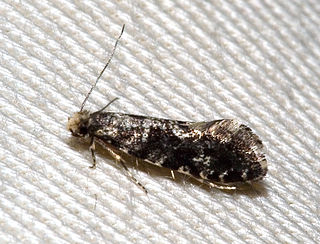
Tineidae is a family of moths in the order Lepidoptera described by Pierre André Latreille in 1810. Collectively, they are known as fungus moths or tineid moths. The family contains considerably more than 3,000 species in more than 300 genera. Most of the tineid moths are small or medium-sized, with wings held roofwise over the body when at rest. They are particularly common in the Palaearctic, but many occur elsewhere, and some are found very widely as introduced species.
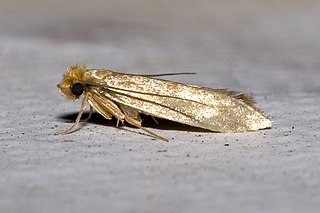
Tineoidea is the ditrysian superfamily of around 4000 moths species including clothes moths, carpet moths, bagworms and relatives. There are five families usually included within it, Eriocottidae, Dryadaulidae, Meessiidae, Tineidae and Psychidae, whose systematics are still under‐studied.
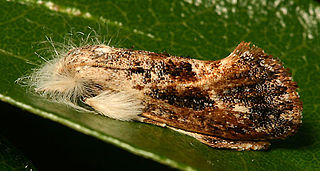
Acrolophidae is a family of moths in the order Lepidoptera. The family comprises the burrowing webworm moths and tube moths. The family holds about 300 species in five genera, which occur in the wild only in the New World. It is closely related to the Tineidae family.

Monopis imella is a moth of the family Tineidae found in Europe.

Erechthias mystacinella, the curve-winged apple moth, is a moth of the family Tineidae. It is found in the Australian Capital Territory, Tasmania and Victoria.
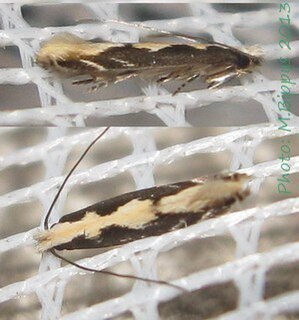
Amphixystis is a genus of moths belonging to the family Tineidae. The family was first described by Edward Meyrick in 1901.
Apreta is a moth genus, belonging to the family Tineidae. It contains only one species, Apreta paradoxella, which is found in California.
Graphidivalva is a genus of moths belonging to the family Tineidae. It contains only one species, Graphidivalva genitalis, which is found in South Africa.
Lysitona is a genus of moths belonging to the family Tineidae. As of 2018, it contains only one species, Lysitona euryacta, which is found in Mozambique.
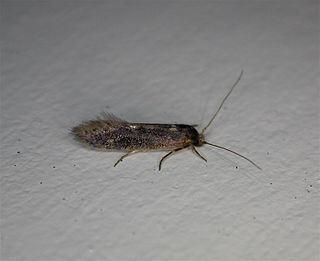
Opogona omoscopa is a moth of the family Tineidae.

Tinea is a genus of the fungus moth family, Tineidae. Therein, it belongs to the subfamily Tineinae. As evident by its name, it is the type genus of its subfamily and family. Established as one of the first subgroups of "Phalaena", it used to contain many species of Tineidae that are nowadays placed in other genera, as well as a few moths nowadays placed elsewhere.
Praeacedes is a monotypic moth genus in the family Tineidae first described by Hans Georg Amsel in 1954. Its only species, Praeacedes atomosella, was first described by Francis Walker in 1863. It has a wide range and has been recorded from Europe, Australia, Hawaii, India, Malaysia, Solomon Islands, Easter Island, Mauritius, Madagascar, Réunion, South America and North America. The species has commonly been misidentified in various parts of the world.
Vactor Tousey Chambers was an American entomologist who specialized in Microlepidoptera. He along with James Brackenridge Clemens, was a pioneer in the study of these insects. He described many new species, with particularly many now placed in Gelechioidea.
Archinemapogon yildizae is a moth of the family Tineidae. It was described by Ahmet Ömer Koçak in 1981. It is found in most of Europe, except Ireland, the Benelux, the Iberian Peninsula and most of the Balkan Peninsula. The habitat consists of birch woodlands.

Haplotinea insectella, the drab clothes moth or fungus grain moth, is a moth of the family Tineidae. It was described by Johan Christian Fabricius in 1794. It is found in all of Europe, except Ireland, the Iberian Peninsula and the western and southern part of the Balkan Peninsula. It is also found in North America. The species is often found in warehouses, granaries, mills and farm buildings.
Infurcitinea ignicomella is a moth of the family Tineidae. It was described by Heydenreich in 1851. It is found in large parts of Europe, except Ireland, Great Britain, Belgium, the Iberian Peninsula, Ukraine and most of the Balkan Peninsula.

Infurcitinea argentimaculella, the silver-barred clothes moth, is a moth of the family Tineidae. It was described by Stainton in 1849. It is found in most of Europe, except Ireland, Portugal, Latvia, Lithuania and the Balkan Peninsula.

Triaxomera fulvimitrella, the four-spotted clothes moth, is a moth of the family Tineidae. It is found in most of Europe, except Ireland, the Iberian Peninsula, Italy, Slovenia and most of the Balkan Peninsula. The habitat consists of woodlands.

Nemapogon clematella, the barred white clothes moth, is a moth of the family Tineidae. It is found in most of Europe and in North America, where it has been recorded from Maryland and North Carolina. The habitat consists of woodlands.
Triaxomasia caprimulgella is a moth of the family Tineidae. It found in most of Europe, except Ireland, Luxembourg, Spain, Finland, the Baltic region and the central part of the Balkan Peninsula.
References
| Wikispecies has information related to Brithyceros . |